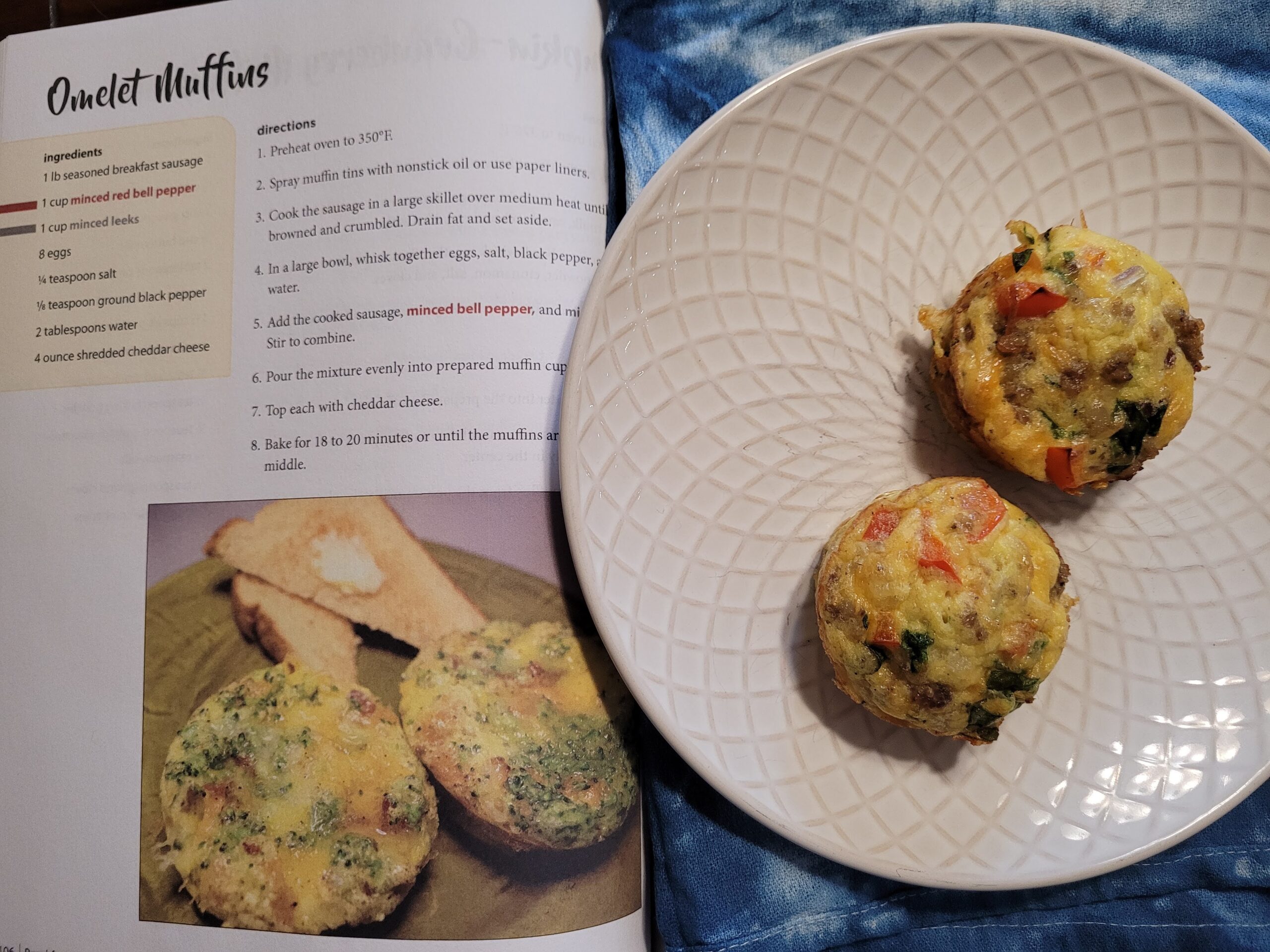I received a galley copy from the author for an honest review. I was not paid for this review and all opinions, thoughts and rants are completely my own.
About the book:

Rather than urging readers to learn to love spinach or zucchini, Herman’s cookbook works with existing taste preferences. The recipes cleverly disguise vegetables in familiar dishes, giving adults a way to enjoy the foods they love while quietly boosting their daily nutrition. Examples include Beef Bourguignon with hidden spinach, Chicken Enchiladas with pureed carrots and onions, and even a chocolate cake where zucchini disappears completely.
This new approach also removes the stigma often attached to being a picky eater. “A lot of adults simply don’t like vegetables, and that’s okay,” Herman explained. “This book provides real solutions instead of guilt, making it easier to eat healthier without sacrificing flavor.”
Rhonda Thornton, a National Board Certified Health and Wellness Coach and Senior Fitness Specialist, contributed to the book and added, “If getting enough vegetables has always been a challenge, you’re not alone. Small, steady changes can transform how your body feels and functions. It’s not about perfection, it’s about creating habits that support your goals, one veggie at a time.”
With more than 90 recipes, over 50 full-color photographs, and practical directions using common ingredients, The Hidden Vegetables Cookbook is accessible to both beginners and experienced home cooks. The collection is designed to make healthy eating simple, indulgent, and stress-free.
The Hidden Vegetables Cookbook reflects Herman’s commitment to helping readers rethink nutrition, proving that healthy food can be both satisfying and enjoyable. More details are available at www.heidihermanauthor.com
About the author:

Heidi Herman spent more than thirty years in the telecommunications industry, becoming one of the most skilled cost management consultants in the country. Her career included specialties in sales, systems installation, training, and contract negotiation, giving her a broad understanding of business which she later applied to entrepreneurship, first in a successful multi-location restaurant and later in a boutique publishing company.
She had authored seven books in four genres, from children’s folklore, to women’s fiction, an award-winning cookbook and a motivational work entitled On With the Butter! Spread More Living onto Everyday Life. Her second cookbook, The Hidden Vegetables Cookbook: 90 Tasty Recipes for Veggie-Averse Adults was released in September 2025. She began a new Women’s fiction series entitled “Life’s a Rodeo”, releasing a novella prequel in October 2025 with the first full-length novel, Crossfire, set to release in December 2025.
Today, she continues to write between time spent on motivational speaking, travel, and a variety of hobbies. Born in the United States, Heidi cherishes the Icelandic heritage passed down from her mother. Heidi loves to travel, sharing Icelandic culture and her books. When she’s not on the go, she is usually found cooking something up in the kitchen. (From her website)
What I thought…
My galley copy was paperback and the pages weren’t of the highest quality. It reminded me of a coloring book. Still, I was excited to delve into this veggie-loving treatise for veggie-haters. I also loved that there were actual donuts on the cover. Herman sets up right away her distaste (almost hate) for vegetables and how it wasn’t until much later in life that she realized she had to embrace them for her health. Hence this book.
The first third (or more) of the book is dedicated to veggie prep or what Herman calls “Core Recipes.” It really is a primer. For instance, she includes instructions for roasting, juicing, pureeing, ricing, freezing and storing everything from beets, kohlrabi, rutabaga to Swiss chard. Most every veggie is mentioned. On the final page of this section, she lists uses for cauliflower and zucchini water (juices). This seemed a little bit disjointed but she does offer great tips.
The first section of actual recipes is entitled “Sauces, Spreads & Jellies.” The two jellies are Fruity Beetroot Jelly and Carrot Jelly (56). Both sounded interesting but I do wish there were instructions for water bathing and preserving them. The Buffalo Broccoli Cheese Sauce (59) is a great idea (reminding me of a broccoli cheese soup recipe) but the base is a can of nacho cheese. I would have liked a more homemade approach. Along the way, there’s a few tips on what to do with these sauces and chutneys (like mixing in cream cheese), but she ties it a bit together at the end in “Sandwich Suggestions”—ideas like smoked turkey and the beet hummus or a PBJ with the Fruity Beetroot Jelly (62).
Next up is the “Appetizers, Soups & Snacks” section. The recipes here are inventive and I do like how she throws riced veggies into almost all of them. Veggie Poppers (7) are little nuggets containing riced cauliflower, broccoli and carrots bound together with mayo, bread crumbs and Parmesan. The Tangy Meatballs (72) have riced carrots and riced broccoli added. Soups include Potato Broccoli Soup, Easy Vegetable Soup, and Slow Cooker Tortellini Kale Soup (73-75).
The “Breads” section was the most innovative and creative. The first recipe, “Broccoli Bread,” is more of a cracker. It contains riced broccoli, eggs, breadcrumbs and salt. I’m not really sure how that bakes up. I did appreciate the veggie addition ideas here—butternut in cornbread and a bit of chopped spinach in yeast buns. There’s a cauliflower pizza crust and another recipe for adding zucchini to a flatbread pizza. There are a couple of quick bread recipes, too, for pumpkin and zucchini.
The “Breakfast” section includes veggies in muffins, frittatas, and quiches. The weirdest recipe here was adding minced Brussels sprouts to a savory waffle (97). Sounds odd but with the addition of some ham and cheddar it makes sense. Another recipe that caught my eye was Morning Potato Nachos (98) which include a base of sweet potatoes topped with bacon, eggs, cheese, jalapenos and salsa. It’s more of a breakfast casserole but I love the idea of serving something called nachos for breakfast! Then, there are those Glazed Beet Donuts that grace the cover (102). These baked donuts do really sound delicious mixing in warming spices with orange peel, beet juice, sour cream and buttermilk. I bet the texture is great.
In “Main Dishes,” Herman sneaks in veggies to a lot of sauce-heavy entrees. She adds riced carrots and minced onions to Beef Bourguignon and adds a bit of beet puree to the sauce (108). Celery and carrots are added to Chicken Enchiladas (110). She adds leeks and carrots to her Beef Po Boys and serves them up on Spinach Buns (112). (Think Italian beef here. It’s a good recipe.) Her Too-Good to Be Veggie Lasagna (113) is actually meat based but mixes in carrots and spinach puree. She adds pumpkin puree to her Beef Stew (121) and serves up Veggie Peanut Chicken on zucchini noodles (122). Sloppy Joes include celery and carrots (130). These all sound delicious and this is probably the section with the most recipes. (I’m obviously not mentioning them all here.)
One would expect a lot of veggies-in-your-face recipes in “Side Dishes,” but Herman continues to be sneaky hiding pureed spinach in one baked bean recipe and kale in another. Of course, there are some veggie forward recipes like a roasted sweet and savory root veggie one (141), Honey Walnut Brussels Sprouts (142), Kohlrabi and Zucchini Fritters (145) and Grilled Vegetables (147). On page 139, she includes a chart to help create your own “Fast Veggie-Infused Side Dishes.”
“Desserts” include a recipe for Spinach Vanilla Cake (154), Kohlrabi Loaf Cake (158) and lots of beet-chocolate pairings. Zucchini and pumpkin make a lot of appearances here too. Weirdest recipe? Kale Coconut Cream Pie (164).
There are a few pictures and because my pages are not glossy, they don’t seem as crisp. Not every recipe has a photo of the finished result and it would have been helpful with a few of them like Shepherd’s Pie Potato Skins (66) and the Bacon Spinach Pesto Roll-Ups (67). This book can be ordered in multiple formats (paperback, paperback with b/w photos, hardcover and ebook). I am assuming that the hardcover book might be of better quality than my galley edition.
I’ve been wanting some quick grab-and-go breakfasts and her Omelet Muffins (106) sounded like the thing. (Plus they reminded me of Starbuck’s egg bites.) The picture that accompanies this recipe definitely looked like it had broccoli in it (which would be a great idea) but the printed recipe just had red bell pepper and minced leeks. I decided to tweak the recipe a bit and replace the leeks with red onions, decrease the sausage amount, and add some spinach. Here’s what I came up with.
Omelets to Go
Based on Omelet Muffins from The Hidden Vegetables Cookbook
Ingredients
- 8 eggs
- ½ t. Kosher salt
- Fresh ground pepper (to taste)
- ½ lb breakfast sausage, crumbled, cooked and drained of excess fat
- 1 c. bell pepper (red, green or yellow), diced
- ½ c. red onions, diced
- 1 c. spinach, chopped
- 4 oz. shredded cheese (your choice)
Instructions
- Preheat oven to 350 F.
- Prepare muffin tin with cooking spray or use paper liners.
- In a large bowl, whisk the eggs with salt and pepper. Add the cooled cooked sausage, bell pepper, onion, spinach and cheese. Stir to combine.
- Pour the mixture into prepared muffin cups. (A large cookie scoop works great for this.)
- Bake for 18-20 minutes until the omelets are set in the middle.
This recipe yielded one dozen omelets (using a regular sized muffin tin).

You could totally decrease the sausage to 1/4 pound and add more veggies (maybe diced Roma tomatoes). You could sub in bacon, ham, or make them vegetarian totally. These were delicious. I liked the red onion taste. I think I would add more spinach next time, too.
Herman’s original recipe uses 1 pound of sausage, 1 cup of minced red pepper, and 1 cup of minced leeks. She also adds 2 tablespoons of water. Since I was adding the spinach, I omitted the water. Use whatever size muffin tins you like but you will need to adjust the cooking time for smaller tins (and larger tins).
I’m not considering the paper and photo quality from my final review because this is a galley copy. There are some inventive (and strange) ways to hide vegetables so I appreciate that. I will be working my way through the book. If you’re looking for ways to incorporate raw veggies or more vegetarian recipes, this might not be the book for you.
If you truly need to hide the veggie goodness in your meals, then pick this up.
I’m a pro at hiding vegetables LOL. Having 6 kids will do that to you!!
I’m going to check out this cookbook to see what ideas I’ve missed.